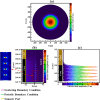Citrate polymer optical fiber for measuring refractive index based on LSPR sensor
- PMID: 39128906
- PMCID: PMC11317514
- DOI: 10.1038/s41598-024-69083-2
Citrate polymer optical fiber for measuring refractive index based on LSPR sensor
Abstract
Fiber optic localized surface plasmon resonance (LSPR) sensors have become an effective tool in refractive index (RI) detection for biomedical applications because of their high sensitivity. However, using conventional optical fiber has caused limitations in implanting the sensor in the body. This research presents the design and construction of a new type of polymer-based LSPR sensors to address this issue. Also, finite element method (FEM) is used to design the sensor and test it theoretically. The proposed polymer optical fiber (POF) based on citrate is biocompatible, flexible, and degradable, with a rate of 22% and 27 over 12 days. The step RI structure utilizes two polymers for light transmission: poly (octamethylene maleate citrate) (POMC) as the core and poly (octamethylene citrate) (POC) as the cladding. The POF core and cladding diameters and lengths are 700 µm, 1400 µm, and 7 cm, respectively. The coupling efficiency of light to the POF was enhanced using a microsphere fiber optic tip. The obtained results show that the light coupling efficiency increased to 77.8%. Plasma surface treatment was used to immobilize gold nanoparticles (AuNPs) on the tip of the POF, as a LSPR-POF sensor. Adsorption kinetics was measured based on the pseudo-first-order model to determine the efficiency of immobilizing AuNPs, in which the adsorption rate constant (k) was obtained be 8.6 × 10-3 min-1. The RI sensitivity of the sensor in the range from 1.3332 to 1.3604 RIU was obtained as 7778%/RIU, and the sensitivity was enhanced ~ 5 times to the previous RI POF sensors. These results are in good agreement with theory and computer simulation. It promises a highly sensitive and label-free detection biosensor for point-of-care applications such as neurosciences.
Keywords: Local surface plasmon; Poly (octamethylene citrate) (POC); Poly (octamethylene maleate citrate) (POMC); Polymer optical fiber; Refractive index.
© 2024. The Author(s).
Conflict of interest statement
The authors declare no competing interests.
Figures


























Similar articles
-
High sensitivity tapered fiber refractive index biosensor using hollow gold nanoparticles.Sci Rep. 2025 Jan 9;15(1):1458. doi: 10.1038/s41598-025-85739-z. Sci Rep. 2025. PMID: 39789159 Free PMC article.
-
LSPR and Interferometric Sensor Modalities Combined Using a Double-Clad Optical Fiber.Sensors (Basel). 2018 Jan 11;18(1):187. doi: 10.3390/s18010187. Sensors (Basel). 2018. PMID: 29324648 Free PMC article.
-
Ultrasensitive tapered optical fiber refractive index glucose sensor.Sci Rep. 2023 Mar 18;13(1):4495. doi: 10.1038/s41598-023-31127-4. Sci Rep. 2023. PMID: 36934144 Free PMC article.
-
Intensity-Modulated Polymer Optical Fiber-Based Refractive Index Sensor: A Review.Sensors (Basel). 2021 Dec 23;22(1):81. doi: 10.3390/s22010081. Sensors (Basel). 2021. PMID: 35009621 Free PMC article. Review.
-
Recent Advancements of LSPR Fiber-Optic Biosensing: Combination Methods, Structure, and Prospects.Biosensors (Basel). 2023 Mar 20;13(3):405. doi: 10.3390/bios13030405. Biosensors (Basel). 2023. PMID: 36979617 Free PMC article. Review.
Cited by
-
Challenges in Adapting Fibre Optic Sensors for Biomedical Applications.Biosensors (Basel). 2025 May 13;15(5):312. doi: 10.3390/bios15050312. Biosensors (Basel). 2025. PMID: 40422051 Free PMC article. Review.
-
High sensitivity tapered fiber refractive index biosensor using hollow gold nanoparticles.Sci Rep. 2025 Jan 9;15(1):1458. doi: 10.1038/s41598-025-85739-z. Sci Rep. 2025. PMID: 39789159 Free PMC article.
References
-
- Liu, B. et al. Hydrogel coating enabling mechanically friendly, step-index, functionalized optical fiber. Adv. Opt. Mater.9, 2101036 (2021).10.1002/adom.202101036 - DOI
LinkOut - more resources
Full Text Sources
Miscellaneous

